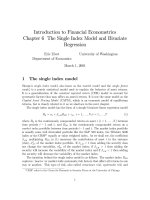Chapter 6 (index) student
Bạn đang xem bản rút gọn của tài liệu. Xem và tải ngay bản đầy đủ của tài liệu tại đây (162.07 KB, 35 trang )
Chapter 6
Index numbers
Index Numbers
Index numbers allow relative comparisons
over time
It measures the percentage change in the
value of some economic commodity over time
Index numbers are reported relative to a Base
Period Index
Base period index = 100 by definition
Notes
‘Economic commodity’: used to describe
anything measurable which has some economic
relevance.
‘Economic commodity’ can be: price, quantity,
wage, productivity….
Index numbers must always be related to some
time period (i.e. base time period and another
time period)
Examples
If the index number values are:
130
95
250
Index Relatives
Index relative or simple index number is
an index number which measures the
change in a single distinct commodity
Index Relatives
Formula:
yt
I y �100
y0
where
Iy = index number of commodity ‘y’
yt = value of commodity ‘y’ at time t
y0 = value of commodity ‘y’ in the base period
Index Numbers: Example
Company orders from 1995 to 2003:
Year
Number
of Orders
1995
272
1996
288
1997
295
1998
311
1999
322
2000
320
2001
348
2002
366
2003
384
Index
(base
year =
2000)
Index Numbers: Interpretation
Price relatives
Formula
pt
I p �100
p0
Where:
pt: price at time t
p0: price in the base period
I p (2003/ 2000)
The
price
index
for
2003,
120
based on 2000(as 100), is 120
Quantity relatives
Formula
qt
I q �100
q0
Where:
qt: quantity at time t
q0: quantity in the base period
I q (2003/2000) 150
The quantity index for 2003,
based on 2000 (as 100), is 150
Example
Calculate price index relatives and quantity index
relatives
Item Uni
s
t
Price (USD)
Quantity
(p0)
(pt)
(q0)
(qt)
A
kg
3,0
4,5
1000
1100
B
m
5,0
6,0
2000
2400
C
l
2,0
2,2
4000
4200
Time series of relatives
Describe how the values of an index relative
change overtime.
There are two distinct ways in which relatives can
be calculated
- Fixed base relatives: each relative is calculated
based on the same fixed time point
- Chain base relatives: each relative is calculated
with respect to the immediately preceding time
point
Fixed base relatives
Year
2000
2001
2002
2003
2004
2005
Sales
(1000 USD)
10.0
10.2
11.0
11.8
13.0
14.8
Fixed base
relatives
(2000=100)
Fixed base
relative
(2002=100)
Chain base relatives
Year
2000
2001
2002
2003
2004
2005
Sales
(1000 USD)
10.0
10.2
11.0
11.8
13.0
14.8
Chain base
relative
Changing the base of
fixed base relative
Used when the old base time point is no longer
relevant (usually it is too far in the past or out of
date)
Step 1: Choose the required new base time
point and identify the corresponding relative.
Step 2: Divide each relative in the set by the
value of the relative identified above and multiply
the result by 100.
Changing the base of
fixed base relative
Year
2000
2001
2002
2003
2004
2005
Old Index
(1980=100)
244
260
270
285
300
315
New Index
(2000=100)
100
106.56 110.66 116.80
122.95 129.10
Time series deflation
A technique used to obtain index relatives that measure
the changes in the real value of some commodity with
respect to a given indicator
Year
2000
2001
2002
2003
2004
2005
Average daily
wage (USD)
10
15
17
19
22
25
CPI
104.3
106.8
107.8
109.8
110.5
112.6
What is the real wage index for 2005?
Time series deflation: procedure
Step 1: Choose a base for the index of real
values of the series
Step 2: For each time point, find the ratio of the
current value to the base value
Time series deflation: procedure
Step 3: Multiply by the ratio of the base indicator
to the current indicator
Step 4: Multiply the result by 100
Real value Index (RVI)
Formula:
xt I 0
RVI � �100
x0 I t
Where:
xt :
x0 :
It :
I0 :
The value at time t of a given time series
The value at base time point of a given time series
The indicator at time t
The indicator at base time point
Time series deflation: example
Year
2000
2001
2002
2003
2004
2005
Average
daily wage
(USD)
10
15
17
19
22
25
CPI
104.3
106.8
107.8
109.8
110.5
112.6
Real wage
index
Composite index numbers
A composite index number is an index number
obtained by combining the information from a set
of economic commodities.
It measure the percentage changes of a group of
items (not one item)
Weighting of components
Usually, a composite index can be calculated by
weighting each component.
A weighting factor is an indicator of the
importance of each component in calculating the
composite index
The need for weights (read in the textbook)
Types of composite index number
1.
Weighted average of relatives
Weighting the index relative calculated for
each component
2.
Weighted aggregates
Multiplying each component value by its
corresponding weight and adding these
products to form an aggregate
Weighted average of relatives
Formula:
I AR
wI
�
�w
Where:
w: weighting factor of each component
I: index relative of each component









